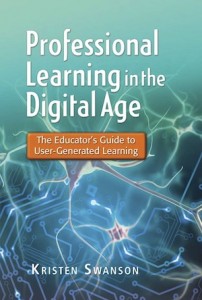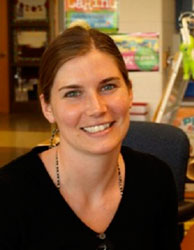Dear school leader,
 Really tired of ho-hum, sit-n-get professional development? You’ve been there, done that. Why not take control of your own learning? You are the lead learner in your classroom, aren’t you?
Really tired of ho-hum, sit-n-get professional development? You’ve been there, done that. Why not take control of your own learning? You are the lead learner in your classroom, aren’t you?
Do you model for your staff and students that you are a learner first and foremost? Embark on a user-generated learning experience, and you won’t regret it. But where to begin?
Dr. Kristen Swanson is an accomplished educator who truly understands the power of learning communities and networks. She has served as a classroom teacher, educational technology director, and college instructor. She’s an active blogger and tweeter and a founding member of the Edcamp Foundation.
Her book, Professional Learning in the Digital Age: The Educator’s Guide to User-Generated Learning, is a must-read for educators today and belongs on a small shelf with other valuable connected learning resources like The Connected Educator and What School Leaders Need to Know about Digital Technologies and Social Media.
Do-it-yourself learning
What is user-generated learning? Swanson defines this concept as
learning acquired through active curation, reflection, and contribution to a self-selected collaborative space
She emphasizes that user-generated learning is something you do, not something you “get.” This is such an important point. Too often I encounter educators who believe they have nothing to contribute to online learning spaces. “Who would want to read what I have to say?” they wonder when contemplating beginning a blog of their own. “What would I tweet? Who would care?” they ask when encouraged to jump into social media conversations. Swanson answers those questions by reassuring readers that “everyone has something to contribute. We are all experts in our own ways.”
Swanson delves into three main components of user-generated learning: curation, reflection, and contribution. All three components are integral in helping school leaders and teachers capture the essence of a user-generated learning experience. Consider how Swanson defines each and how you could incorporate the practice into your own professional development.
Curation is “the careful collection of relevant resources,” and Swanson describes the educator’s responsibility to serve as curator in order to find resources to help serve students. Swanson describes new methods of curation and necessary skills such as aggregation and organization in order to manage curated materials.
Reflection is the next necessary component in the process, as the educator processes the information newly curated and consumed and assimilates the new information with current background knowledge. Swanson suggests several effective methods of professional reflection.
Contribution is key to the user-generated learning process, where the educator contributes ideas to his learning communities. Whether through virtual participation or in a physical space, it is essential for educators to share their own unique perspectives and understandings with their learning communities.
Practical and easy to follow
The book’s organization was helpful in navigating the content. Each section of the book contains:
- Educator Cases, to highlight the experience of a practicing educator
- Face-to-Face Protocols, to assist when important personal, not virtual, interactions are necessary
- Research Snippets, to support the practical information shared in the book
- Key Ideas, to help the reader focus on main ideas for understanding user-generated learning
- To-Do Lists, to guide the reader and provide action steps towards becoming a user-generated learner
For any educator wishing to strengthen his or her ability to curate, reflect, or contribute to social spaces, Swanson’s ideas and resources offer support along the way.
She provides practical, easy-to-follow steps towards becoming an effective user-generated learner, and her writing style contributes to an overall enjoyable read.
If you stumbled upon this book review, it’s because you’re connected enough to find your way to the Voices blog. Your task now is to forge ahead and share Kristen’s work with your colleagues who are not yet seizing user-generated learning opportunities and continue to develop your own professional learning networks and connected experiences!
For an even more in-depth discussion about user-generated learning and to interact directly with the author, visit her book website and participate in the current virtual book club that Kristen Swanson is hosting. There are interactive discussions, videos, and Twitter chats to keep you engaged in the content.
Happy learning!
Lyn Hilt
Latest posts by Lyn Hilt (see all)
- User-Generated Learning: A Must-Do for School Leaders Today - January 15, 2013
- Lessons in 21st Century Leadership - April 27, 2012
- What Do We Need Our Teachers to Be? - March 2, 2012



Wow, thanks for the amazing book review Lyn! Your words mean so much as I hold your work in such high esteem! You perfectly captured my intent of reaching newbies in the social media and professional learning space.
Thanks, Kristen, for compiling your research and thoughts on this topic for us. The publication will serve school leaders and all educators well!
This makes so much sense! Sharing information about how to implement a ready curriculum is not really PD. It is just sharing information, and should be labeled as such. Real Professional Development helps teachers and faculty to grow in their profession. Providing these starting points is excellent, because we don’t know what we don’t know, and sometimes a very gentle push is enough for a person to embark on a lifelong journey of autonomous learning.
Hi, Nina, thank you for your comments here. I’m glad this blog post has provided some “getting started” material for school leaders and teachers who are anxious to get started with user-generated learning methods. I agree, it’s up to us to dedicate ourselves to learning autonomously to further our professional development!
I really like this brief book review. If one doesn´t apply what one has learned from somebody else, there is no point in just collecting diplomas.
Joe, thanks for your comment! I’m glad you enjoyed the review and hope that Kristen’s ideas will help further your professional development.
Comment